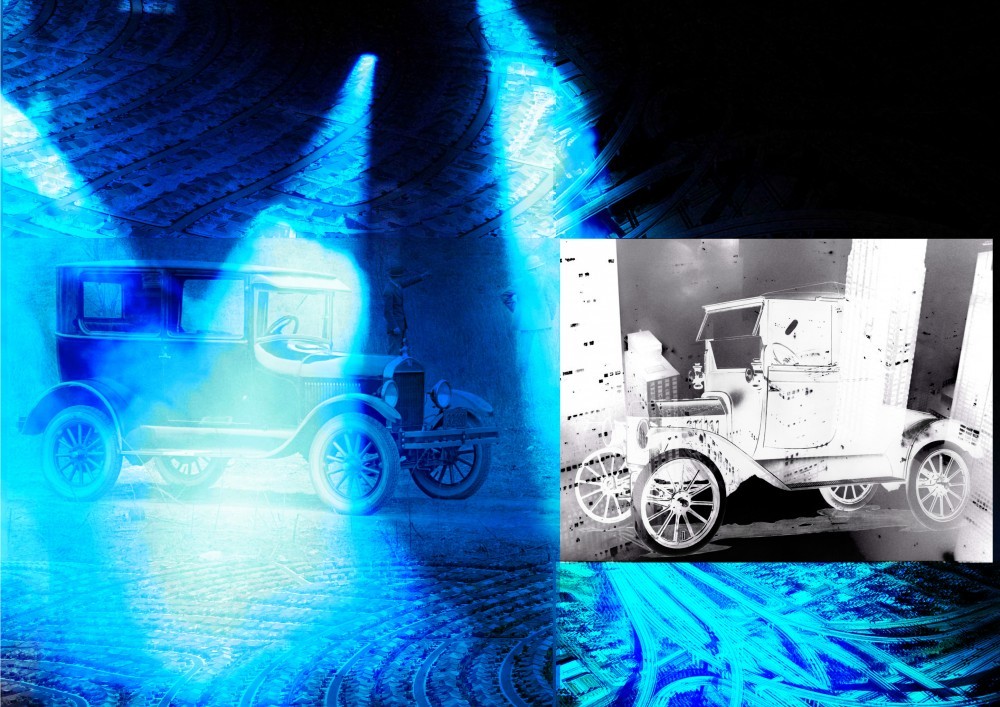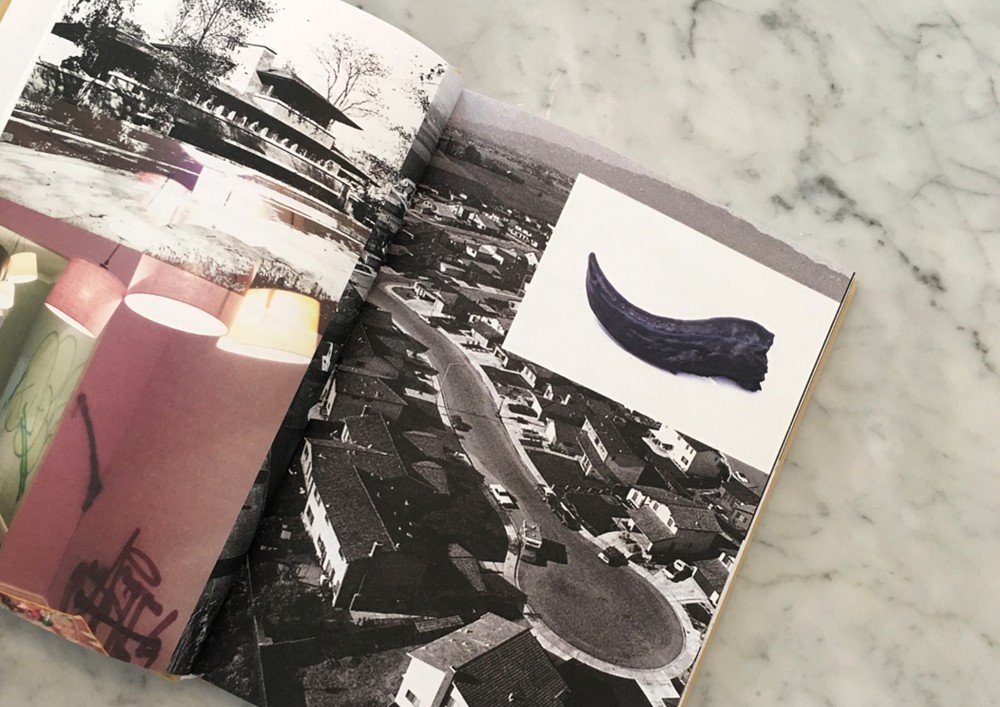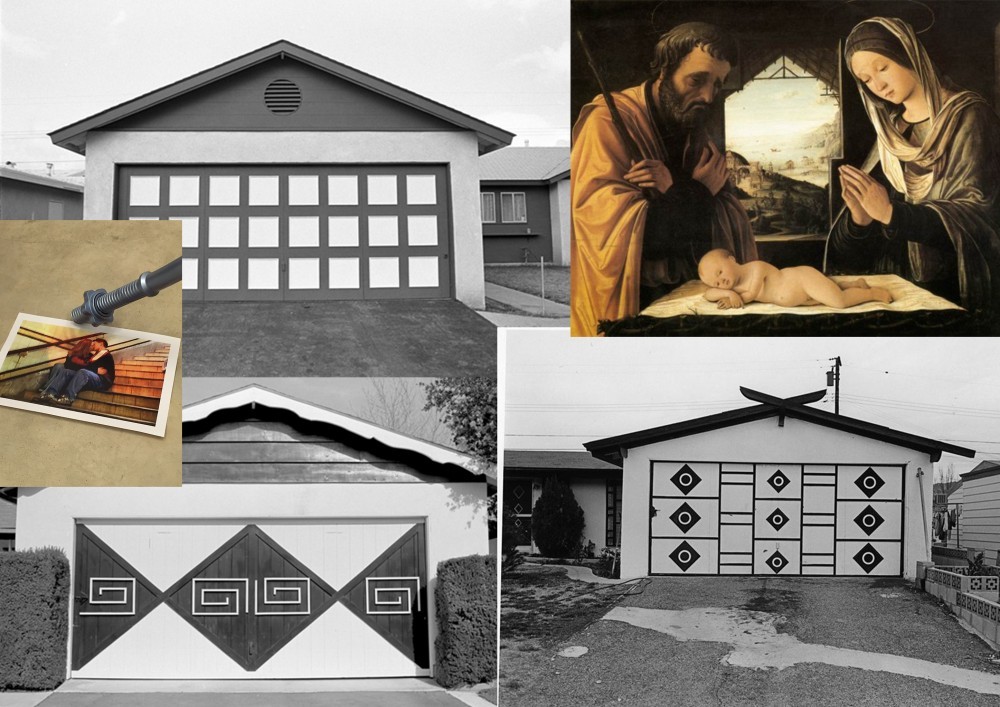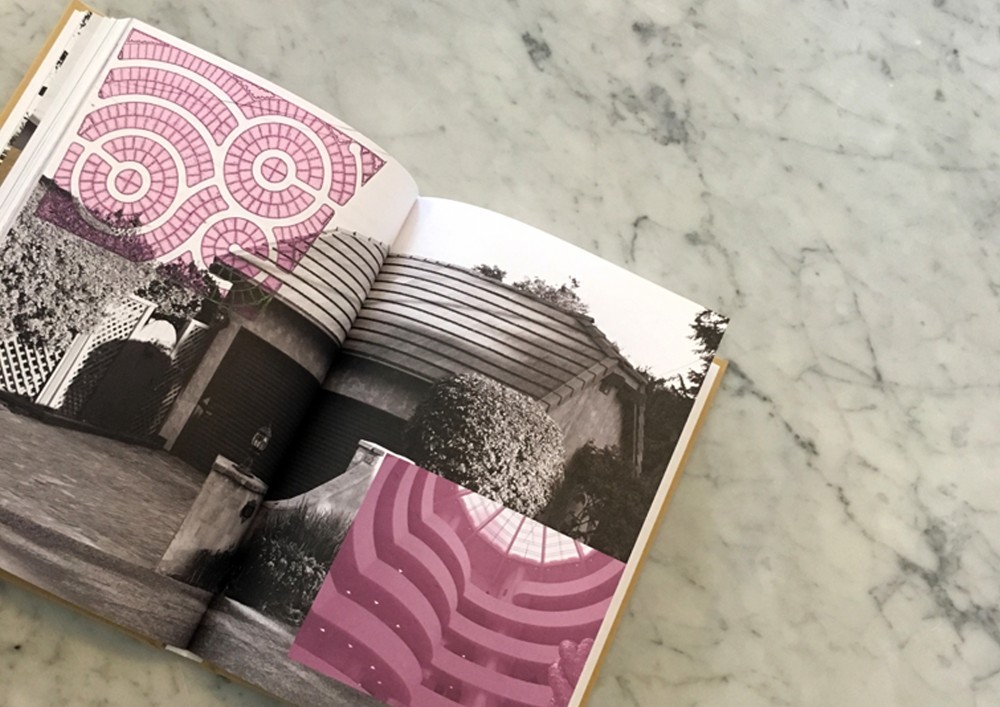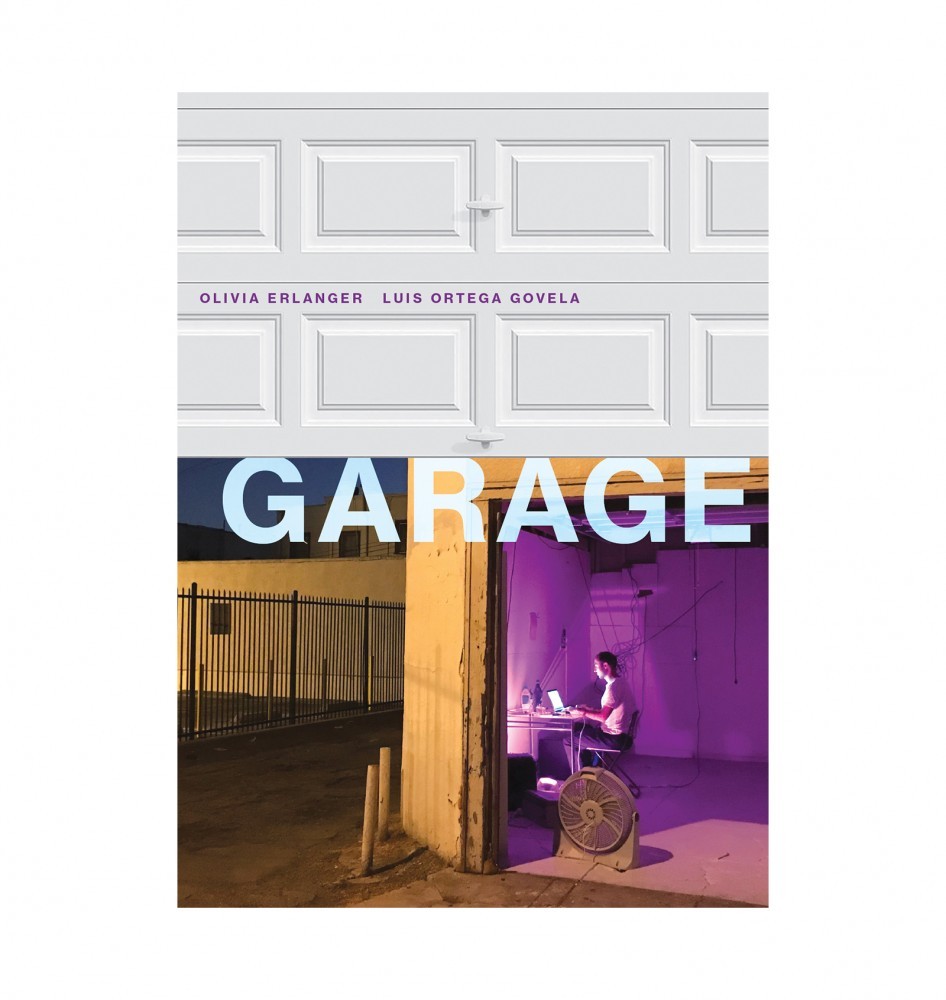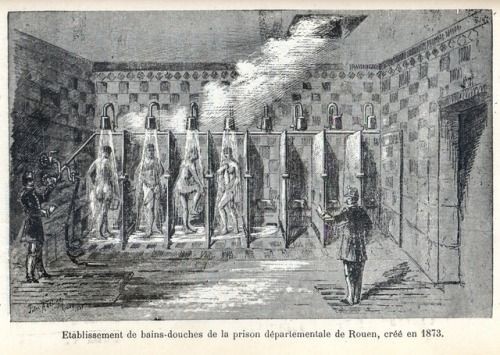The History of the Garage, from Frank Lloyd Wright, the Great Migration, to Modern-Day Suburbia
Garage (MIT Press, 2018), a new book by artist Olivia Erlanger and architect Luis Ortega Govela recounts the secret history of the garage as a space of creativity, from its invention by Frank Lloyd Wright to its use by start-ups and garage bands. Below you can read “Domestication of the Garage,” a chapter from the book, published exclusively in PIN–UP.
DOMESTICATION OF THE GARAGE
I have to believe that the time is not so very far distant when the ‘American Home’ will be really owned by the man who paid for it. It will belong to its site and to the country. It will grow naturally in the light of a finer consideration for the modern opportunity which is a more practicable truth and beauty. An American home will be a product of our time, spiritually and psychically. It will be a great work of art, respected the world over, because of its integrity, its real worth.
— Frank Lloyd Wright
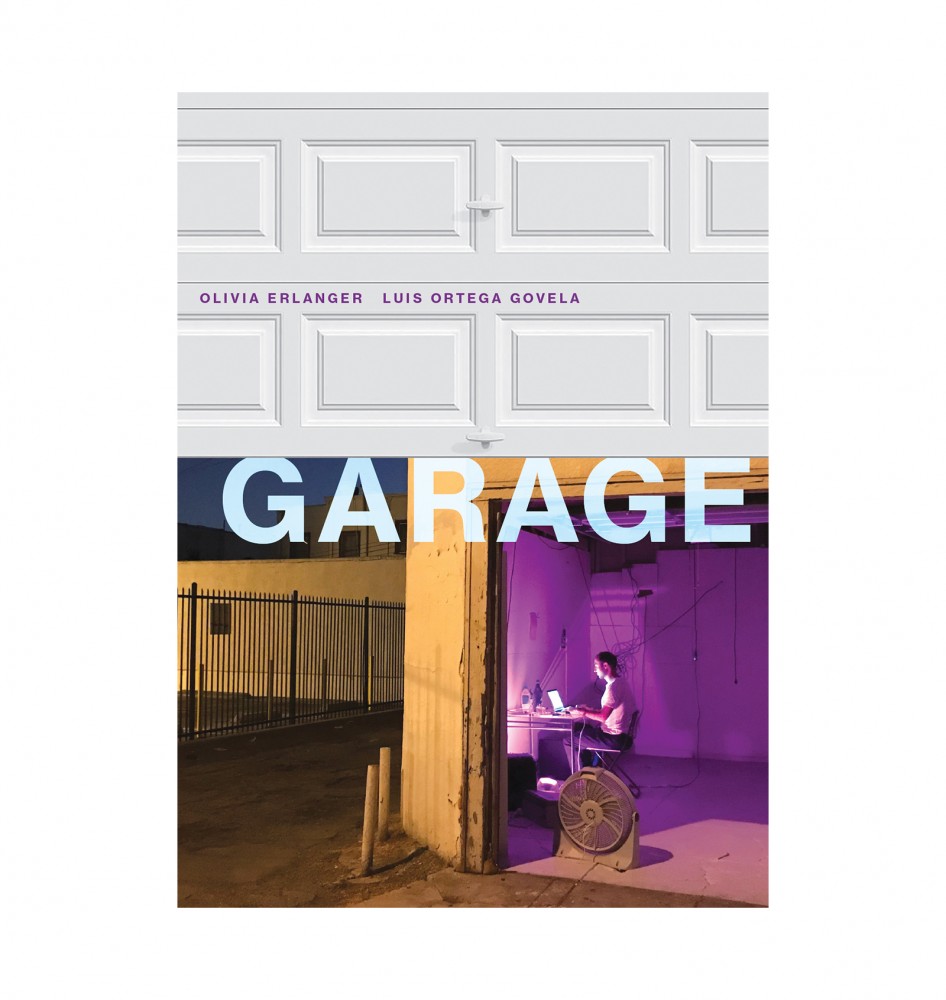
Cover of Garage, a new book by Olivia Erlanger and Luis Ortega Govela. MIT Press, 2018.
The history of the garage tells a story of an architectural technology that has become part of our daily life, while the home itself hoards the secret of its inception. Houses are made from rooms whose functions are dictated by bodily rhythms, circadian, hormonal, and excretory. The skeletal blueprints of where these rooms and machines came from are hidden under a skin of perfectly rendered plaster. To unearth them, one must go room by room, object by object, tracing the hardware back to the bodily and mechanical functions that they were created to accommodate.
The bathroom was originally a bucket in a corner of a bedroom and later became formalized through a hygienic concern into a series of pipes and ceramic addendums that allowed for an ergonomic way of handling digestion and cleanliness. Since its invention it is impossible to have a house without one. In the same manner, bedrooms were usually shared by families, one bed for all, and as bed sizes became standardized into the monogamous double bed, the size of the room changed; its purpose was no longer just for rest but for reproduction and recreation. Similarly, the garage came to be because of the car, and this technology had to wiggle its way into the structure of the home. Walls had to be ripped open, to be piped and wired to begin the process of domestication, of making a piece of hardware part of the inhabitants’ daily life. Technological innovations like these not only changed the typology of the home, they also redefined its meaning and character, introducing strange noises like dripping taps and electric buzzing, rhythms that introduced new patterns of work. In the endless search for comfort, each new innovation is added onto the frame of the home and presented as a given so that they are rarely questioned.

The Robie House dining room with original furniture designed by Frank Lloyd Wright. Credit: Ernst Wasmuth A-G, Photocopy of Plate #115, Frank Lloyd Wright, Ausgefuherte Baute, 1911.
In 1880, 75 percent of Americans lived in rural areas; cut off from city centers, they were disconnected islands of communities. Industrialism changed this, and with it, these local autonomies began their metropolitan migration in search of waged labor. But these densely populated areas lacked the architectural typologies the newly moved were accustomed to, and they were forced into shared apartments. It didn’t take long for them to notice how large an impact this change in residence would have on both the structure and the quality of their daily lives.
The mutually cultivating relationship between man and land that played such a dominate role in rural life was gone, and feeling this drastic disconnect, these newly urban residents longed for an existence that would merge their new and old byt, city and country life, and quell the repercussive anxiety of industrialism that Odo Cheriton captured when he said, “I’d rather gnaw a bean than be gnawed by continual fear.” They wanted urban opulence with rural security, the financial benefits of city life with the peace and quiet of farm life. The solution came in the form of the automobile, an invention that, in its cultural incorporation, would come to change the structure of society in just about every way imaginable, by providing the possibility of creating a significant distance between home and work, refuge and bustling city, not the least of which was its indelible impact on the formation of American suburbia.
On a fundamental level, the car restructured the relationship between space and time. But it also entered our cultural consciousness in a much more proximate way; our relationship with cars became so intimate that they were treated like pets, humanized, given a name and room in our homes. The influence of power this machine had on the rituals of life imbued it with a soul, and the ghost in the machine was created. The machine was not invented to have autonomy; rather it was a piece of metal under our control, feeding back into the psyche of patriarchal capitalism, in which the ego is exerted into everything and everyone around you, forming a ventriloquist-dummy dichotomy, in essence the dream of sub- urban reproduction was embodied in the car-human relationship. The car became the favored family pet, exploited and cared for by all. In creating a space in our culture for cars, however, cars and their manufacturers ended up influencing elements of our culture. This seemingly spontaneous glorification of the car is attached to a dark history of corporate interests and national economic reinvigoration schemes seeping into the home. Endemically, as if a parasite, the business of car manufacturing ruled and began to dictate existence; each garage built marked the successful adherence of the technology into everyday life.
With the advent of the car, the domestic realm was changed. This technology allowed for the house to be disconnected from its surroundings. The home was no longer attached to the land; rather, because of the car’s needs, it was built around an infinite grid of streets and highways. The smooth paved roads allowed for an expansion of life, bringing commerce and food to previously dead areas; the areas outside of cities flourished with the new blood, ushering in the dawn of suburbia. Food was no longer grown on the family’s plot of land but rather was bought, shipped from around the country, with seeds altered, grown in greenhouses, and transported. The car was like a cargo ship that transformed the disconnected and quaint harbor into a trading center.
The domestication of the garage refers to the process by which the car and the room that held it became necessities in America’s existence. The car offered a form of automated autonomy, a new kind of consumptive individualism. At the same time that the car made its way into the home, so too did television introduce moving images and media, allowing the family to consume in new ways. The home was liberated from its previous productive functions: food, clothes, education, healthcare, and entertainment became positioned strategically between home and car. Walking became unnecessary, almost a burden. This new vernacular held a promise of domestic bliss in which leisure became a form of gas-guzzling consumption. Suddenly, the space of refuge and rest was connected to an infrastructure of roads and highways that displaced domestic functions outside the home, morphing the house into little more than a dormitory. This restructuring placed the importance within a family on the organizations that they belonged to, the office they worked at, the country clubs they attended, the car they drove, and the clothes they wore. It was a corporatization of the suburb and its inhabitants.

Ford’s Model T was released in 1908 and was the first mass-manufactured car. Decreasing production costs made it possible to popularize the new machine. Car manufacturers, Ford among them, lobbied for the infrastructure necessary to operate a car in an increasingly privatized America, manipulating the development and spread of a highway system. Credit: Ford Model T, Tudor Sedan 1926. Collections of Henry Ford. Collage by Luis Ortega Govela.
America saw in the car a technology that could and would support the speculation of land value and development beyond the urban center and a much more connected populous through the invention of a national infrastructure of highways and roads. The garage is an invention of an industrial society ruled by Fordism, and the spread of this typology was the beginning of the modern suburban construct. The intertwined histories of the garage and suburbia were written by legislators through economic pressure on the national government during the first financial crises of the twentieth century.
Following the economic decline on Black Tuesday in 1929, cities began to fill up with the unemployed, and families who were limited to one job per household re-relegated women back into the domestic sphere. Without jobs, the housing market also went into crisis, and with the closure of banks, homeownership trailed behind. Without a house in which to reproduce, the national birth rate, which shed light on the future of the country’s labor force, came tumbling down. The domino effect of destruction, in which financial institutions first destroy themselves, then each other, and eventually the consumer, was set in motion, and the Roosevelt administration, in an attempt at prevention, began to strike a New Deal.
Home construction became the antidote for crises through the creation of the Federal Housing Administration in the National Housing Act of 1934. Keller Easterling, in her book Call It Home, describes the FHA as the legal transformation of “houses into a kind of currency.” During the Great Depression, the house connected two areas in distress: employment and banks. To incentivize home construction, the FHA created the low-interest long-term mortgage as a way to reinvigorate the American construction industry and to provide new jobs. Stimulating the moderate-cost private-housing market, the mortgage proliferated homeownership, but it also meant that you could own a house without having to pay in full for it, which created a debt system in which ownership was an illusion attached to increasing interest rates.
Inasmuch as the car provided new connections between the family and the outside world, the automobile offered a different mode of transport whose infrastructure had yet to be built. Floating, suspended in metal and plastic, burning oil over roads and streets, the car needed a circulatory system to move across the landscape. As the FHA was releasing the first mortgages Washington began to pump money into infrastructure projects that would further help to prop up the economy. While the car was undoubtedly a great tool there existed proposals for modes of transport that would bend toward the multitude rather than the individual. Electric streetcars and utopic visions of high-speed trains could have connected America, but instead car manufacturers strongly lobbied for the construction of highways, further reinforcing the concept of self-reliance and solidifying the car as the sole mode of transport, while at the same time providing the automotive industry with a clientele that constantly needed their product.
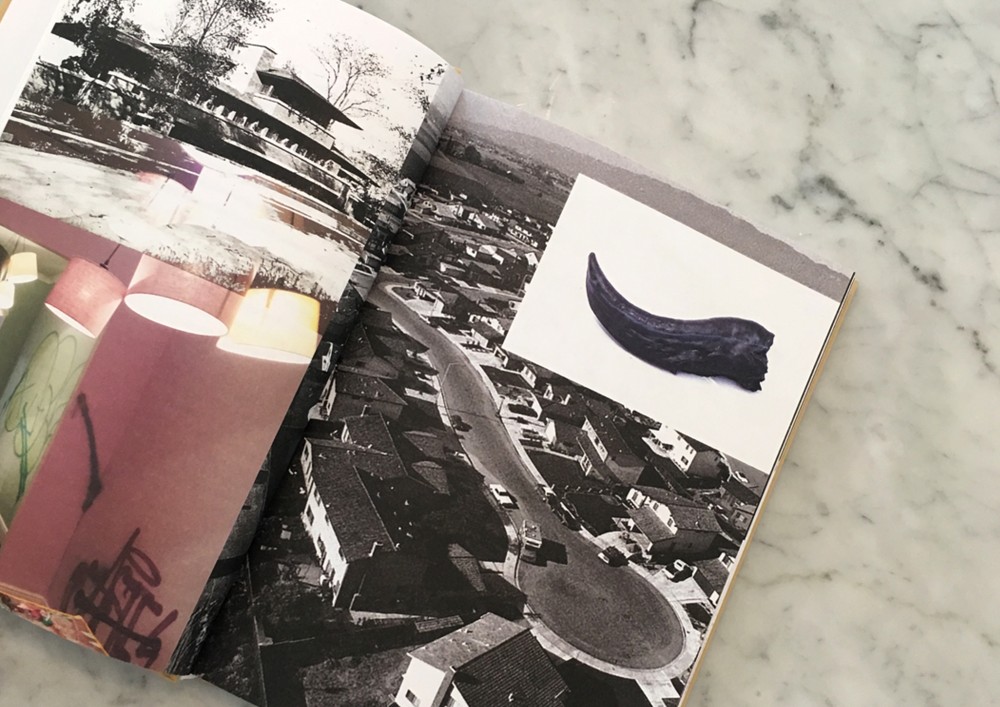
The garage has come to define the twentieth century as the space for innovation, from Frank Lloyd Wright's Robie House, in which the garage was first attached to the home, to becoming the architectural technology by which suburbia and its family could proliferate in the American landscape. The garage has also defined the new corporate aesthetic of domestic signifiers in the office landscape as explored by åyr in their project, Comfort Zone. The tongue, a sculpture by Olivia Erlanger entitled Rip, considers the cow tongue as a force changing the ecology and structure of the American heartland, and is used as a signifier of consumption.
In coalition with car manufacturers, a great deal of propaganda was released by the FHA against the urban row house. Targeting the squalor of the city and exacerbating the problems inherent in metropolitan living, it promoted the suburbanization of the American territory. But the promise of suburbanization came with densely packed fine print. First, the institution would finance only single-family detached homes in peripheral areas, for these were seen as more secure investments. Second, if the house didn’t come with a garage it would not be able to get a mortgage. Thirdly, the homeowner had to be white.
The suburbs were a white-washed profit-driven endeavor, a state-sponsored sprawl created to incentivize economies that were destabilized during the Great Depression. The safety that suburbia produced was cultivated to further property speculation and keep the wealth among the few and predominantly paler skinned. Carefully protected by covenants and zoning laws, suburban expansion zones were deliberately resistant to change; they operated like farmland, with humans as seedlings, cultivating subplot developments to increase value. What began as monocultural societies founded on racist practices turned into cultural and ideological deserts, devoid of diversity. Life became so monotonous it seemed dead.
The density of urban life may have found its overflow in the suburbs but this catch basin never caught the polyphony that presented itself in urban spaces. Suburbia was a response to the Great Migration of the former slave populations from Southern to Northern states. This movement began in hopes of finding new opportunity and as a means to escape a landscape embedded with persecution and oppression. The Northern states promised equality and work, and between 1910 and the 1930s the area above the Mason-Dixon line witnessed a drastic shift in the race of laborers. The Italian and Irish populations that were previously relegated to the lowest faction of the workforce now had competition.
As many major cities felt the increase of a freed black workforce white flight began. This was the movement of white people out of the city and into the surrounding areas. The Jim Crow era masked its prejudice through an experiment in architectural eugenics that denied housing rights to people of color. The use of racially exclusive deeds became such a common practice across the United States that it was validated in 1926 by the Supreme Court.
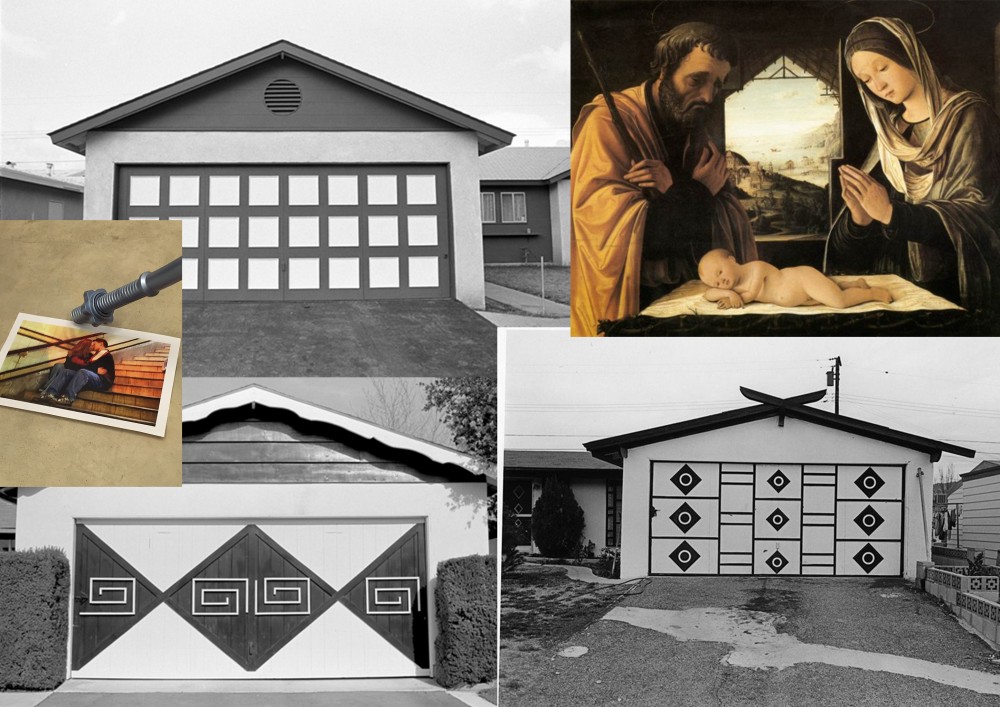
Photographs of garage doors from John Divola’s 1970s San Fernando Valley Series, Lorenzo Costa’s nativity scene depicting the birth of Christ in a stable. A picture from an installation in a startup incubator by Olivia Erlanger and Luis Ortega Govela showing a teenage kiss in a photograph held down by a lavender dumbbell. Mood board by Luis Ortega Govela.
Background photos: John Divola, San Fernando Valley Series (1970-1973)
Left photo: Olivia Erlanger and Luis Ortega Govela, Partnership (2015)
Right photo: Lorenzo Costa, Nativity, Musée des Beaux-Arts, Lyon
After the New Deal, the federal government took a red pen to the map of the metropolitan areas of the United States, marking the areas that were “unsafe” for mortgages. This process known as “redlining” became the norm. It wouldn’t take long to notice that it was only African American neighborhoods that were inked up, arbitrarily deemed too risky to provide assistance to. Without any way to quantify or justify these demarcations, prejudice became the calculator for risk.
Although the deed covenants were found unenforceable by Shelley vs. Kramer in the late 1940s, structural racism was already bleeding at the core of the American suburb. Discrimination and segregation were embedded in the foundation of suburbia as single-unit housing developments spread, with new developments like Levittown, a colony of 17,000 homes open to rent in 1956. The funding for the construction came from the FHA, and it carried the condition that no homes be sold to African Americans.
Even though suburban enclaves had existed before, the introduction of the garage created a new suburbia. A purely residential zone neither urban nor rural, it was the land of an American dream, that of the individual homeowner. This new residential landscape aided by the car presented an antiurban strategy that denied industry, commerce, ethnic diversity, and the intermingling of social classes within the residential domestic environment. The more neutral, homogenized, and quantifiable the suburb and its inhabitants, the safer the investment. The suburb was designed for a white middle class, yet the whiteness contained within, rendered so perfectly, became a totalizing force in a global imagination. The imperialist power of suburbia became a global aspiration that acts as force of social control, by imposing gendered roles, racist practices, and general aggression toward the other, even if it is an internalized other. All these efforts made whiteness into the pinnacle of every hierarchy.
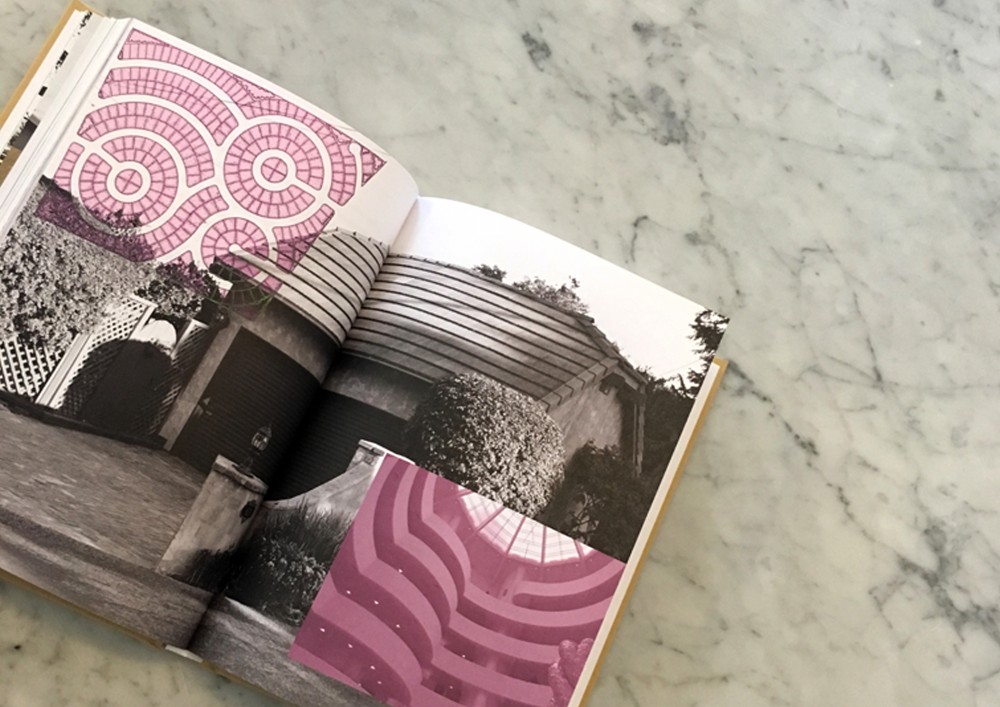
A suburban garage collaged with a sketch of a Joseph Eichler development and a photo pf the interior of the Guggenheim originally designed by Frank Lloyd Wright as a pink concrete car viewing platform.
This domestic enclave became the smallest unit of the nation. The garage as much as the suburb was the symbol of white heterosexuality. Children were going off to school and getting high in parking lots, patriarchs were going to the office and finding solace in work, and mothers were somehow still tied to the house contemplating what, if not their own head, would be best cooked in the oven. The family was together but no longer at home. The separation between the place of work and the home was a gradual transformation of a patriarchal economy.
The domestication of the garage reveals the home in its process of financialization, as the space of the virtual encounter between the habitual and global economic forces. In the garage and the home, there is no longer a clear division between the personal space of domesticity and the immateriality of the financial. Through its economic value, the home reveals that it was transformed from a space of refuge to our primary financial asset. It acted as a testing ground for corporate interests. The explicit collision between the domestic sphere and the marketplace found in the garage reveals the conditions through which we exist today: human capital living in commodities.
Text by Olivia Erlanger and Luis Ortega Govela.
On Thursday, December 13, 2018, Olivia Erlanger and Luis Ortega Govela will be launching Garage in New York City with a conversation with PIN–UP editor Felix Burrichter.
GAVIN BROWN'S ENTERPRISE
Thursday, December 13th
7:00 – 8 PM
291 Grand Street, 3rd Floor
New York NY 10002, USA
FREE ADMISSION

